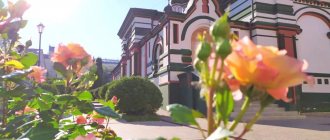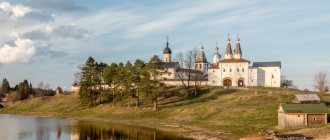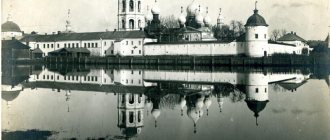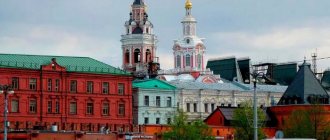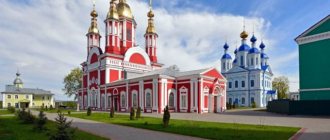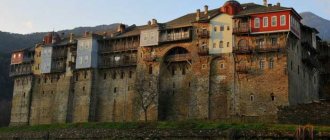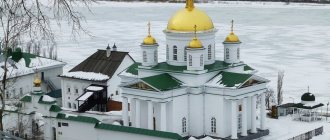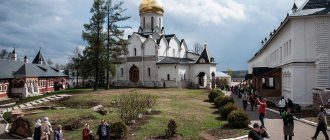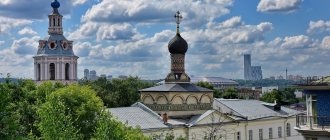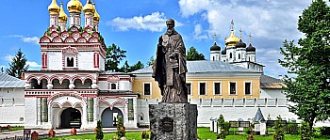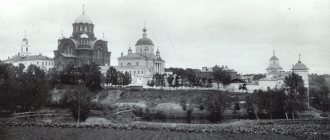| Mother of God Nativity Monastery in Moscow, 2012. Photo by A.P. Sycheva from the site sobory.ru |
Convent in honor of the Nativity of the Blessed Virgin Mary in the city of Moscow
, stauropegy of the Russian Orthodox Church within the boundaries of the Moscow diocese;
in the 17th-18th centuries it was called “ Virgin on the Trumpet
” [1]
- Address: Russia, 107031, Moscow, st. Rozhdestvenka, 20
- Tel.
- On the map: Yandex.Map, Google map
Founded in 1386 by the mother of the hero of the Battle of Kulikovo, Prince.
Vladimir Andreevich Brave, the wife of Prince Andrei Ivanovich Serpukhovsky, Princess Maria, on the outskirts of the city, on the steep bank of the Neglinka River, on the very edge of Kuchkov Field. In 1501-1505, a stone cathedral in honor of the Nativity of the Blessed Virgin Mary was erected in the monastery, currently surrounded by outbuildings from the 17th century.
The new cathedral was damaged in a fire in 1547, but was soon rebuilt. In the southern altar apse, by order of Tsar John IV, the St. Nicholas chapel was built, to which a refectory was added in the 17th century.
At the end of the 18th century, the cathedral was surrounded on the northern and southern sides by a covered porch, in which chapels were built in honor of the Descent of the Holy Spirit in 1814 and in the name of St. Demetrius of Rostov in 1820.
In the 1870s, the tomb of the Lobanov-Rostovsky princes was added to the eastern side of the cathedral; in the 19th century, a second floor was added, which housed the monastery sacristy. At the expense of Princess Photinia Ivanovna, a stone church in the name of St. John Chrysostom was built in 1676-1687.
| Mother of God Nativity Monastery, Cathedral of the Nativity of the Blessed Virgin Mary, 2015. Photo: Yu. Bulkin |
In the 16th century, above the southwestern corner of the Nativity Cathedral there was a belfry, dismantled in the 17th century and replaced by a hipped bell tower, which was destroyed by a lightning strike in 1835.
The bell tower over the Holy Gates was built in 1835-1836 according to the design of the architect N.I. Kozlovsky. In the lower tier of the bell tower, at the expense of S.I. Shterich, a church was built in the name of the Hieromartyr Eugene, Bishop of Kherson. The cell buildings of the 17th-19th centuries, located along the eastern wall of the monastery fence, as well as the abbot's buildings, have been preserved. The building of the Church of the Kazan Icon of the Mother of God with a refectory was erected in 1904-1906 according to the design of the architect Vinogradov in the Russian-Byzantine style. The construction of a stone fence with four corner towers was carried out in 1671 at the expense of Princess F.I. Lobanova-Rostovskaya. In 1882, the monastery received a new fence, built partly on the basis of the previous one.
At the beginning of the century, there were quite a lot of ascetics in the Nativity Monastery; a shelter for orphan girls and a parochial school operated at the monastery.
In 1922 the monastery was closed. Almost no traces of the ancient monastery cemetery have survived. The following were buried in the monastery: its founder Princess Maria (in the schema Martha, + December 2, 1389), the wife of Vladimir Andreevich the Brave Princess Elena (+ 1452), representatives of the Lobanov-Rostovsky family.
Since 1989, services have been resumed in the Nativity Cathedral. The monastery has existed again since July 1993.
Statistics
- beginning V. - abbess, 23 sisters, 15 designated and 210 non-designated novices.
Abbesses
- Anisia (1547)
- Marfa (Smyvalova-Zherebina) (1634,1638)
- Marfa (Smyvalova-Zherebina) (1642 - 1655)
- Marfa (Smyvalova-Zherebina) (1659)
- Iraida (1666)
- Vera (Kolycheva) (1669)
- Taisiya (1677 - 1678)
- Martha (1685 - 1690)
- Alexandra (1697 - 1699)
- Eupraxia (Stukolova) (1702 - 1707)
- Apollinaria (Khvitskikh) (1708 - 1711)
- Pamphylia (Vodoratskaya) (1711 - 1729)
- Evstolia (Lodygina) (1730)
- Capitolina (Zhukova) (1731 - 1739)
- Alexandra (1762 - 1773)
- Euphrasia (1773 - 1782)
- Paisia (1792)
- Esther (1812 - 1815)
- …
- Afanasia (Shipova) (1840 - January 29, 1865)
- Euphrosyne (Kashkadamova) (December 1, 1866 - June 18, 1878)
- Seraphim (Von-Lesken) (June 26, 1878 - 1887 [2])
- Juvenalia (Lovenetskaya) (October 1902 - 1922)
- 1922 - 1993 monastery closed
Russian Orthodox ChurchFinancial and economic management
Story
The Mother of God Nativity Stauropegic Convent was founded in 1386 by the wife of Prince Andrei of Serpukhov and the mother of Prince Vladimir the Brave - Princess Maria Ivanovna, daughter of the Galicia-Dmitrov Prince Ivan Fedorovich, a descendant of Grand Duke Vsevolod the Big Nest.
According to the Trinity Chronicle and the Rogozh chronicler, Princess Maria Andreeva (that is, the wife of Prince Andrei) took monastic vows in the monastery she created in the schema with the name of Martha, died on December 2 (15) and was buried in the monastery.
According to a number of historians, at first the monastery was located on the territory of the Moscow Kremlin and was called: the Monastery of the Nativity of the Virgin Mary on the Moat
. Other experts believe that from the moment of its foundation the monastery was located on the banks of the Neglinnaya River, near Kuchkov Field, in the possession of Prince Vladimir Andreevich Serpukhovsky.
In the 1430s, Princess Elena Olgerdovna, the wife of Prince Vladimir the Brave, took monastic vows in the monastery with the name Eupraxia. Princess Elena donated monasteries to villages and villages. And she was buried, according to her will, in the monastery cemetery in 1452.
The single-domed stone Cathedral of the Nativity of the Blessed Virgin Mary was erected in 1501-1505 in the traditions of early Moscow architecture. After the fire of 1547, for 150 years it was surrounded by extensions that changed its original appearance.
On November 25, 1525, in the Nativity Monastery, the wife of Vasily the Third, Solomonia Saburov, was forcibly tonsured under the name Sophia and lived in the monastery until she was transferred to the Suzdal Intercession Monastery.
In the summer of 1547, during a severe Moscow fire, the buildings of the monastery burned down and the stone cathedral was damaged. It was soon restored according to the vow of Tsarina Anastasia Romanovna, the wife of Ivan the Terrible. By order of the Tsar himself, the St. Nicholas Chapel was created in the southern altar apse.
In the 70s of the 17th century, the Nativity Monastery became the burial place of the Lobanov-Rostov princes: their tomb was attached to the cathedral from the east. In the 19th century, it received a second floor, which housed the monastery sacristy.
In 1676-1687, at the expense of Princess Fotinia Ivanovna Lobanova-Rostovskaya, a stone church of St. John Chrysostom with a refectory and chapels of St. Nicholas, Righteous Philaret the Merciful and St. Demetrius of Rostov was erected. At her expense, in 1671, a stone fence with four towers was built.
XIX-XX centuries
From September 5 to November 1812, the monastery was occupied by Napoleon's troops. The monastery has preserved a legend about a miracle from the icon of St. Nicholas: an enemy soldier, trying to tear off the frame from the miraculous icon, was severely injured, became numb and could not move, so they carried him out of the church in their arms. The invaders did not harm any of the civilians hiding on the territory of the monastery, although behind the fence, near the northern wall, they shot Muscovites suspected of arson.
The monastery was not damaged by fire during Napoleon's invasion. Only in the refectory chamber of the Nativity of the Virgin Cathedral did the occupiers set up a stable. But in the Church of St. John Chrysostom, divine services continued to be held daily.
In 1812, a chapel of the holy righteous Philaret the Merciful was built in the Church of St. John Chrysostom. In connection with the emergence of chapels, wide arches were built in the southern and northern walls of the quadrangle. At the end of the 60s of the 19th century, the aisles were rebuilt, maintaining the same style and architectural features. The great consecration of the chapel of the holy righteous Philaret the Merciful was performed in 1869 by Saint Innocent (Veniaminov), Metropolitan of Moscow (see Tokmakov I.F. A brief historical sketch of the Moscow Nativity Convent. Op. op. p. 15).
The three-tiered bell tower with the Church of the Hieromartyr Eugene of Chersonesos (architect N.I. Kozlovsky) was built in 1835-1836 in the classical style on the site of the central entrance to the monastery: in its lower tier the main entrance of the monastery was created - the Holy Gates. Above the entrance was the gate temple of the holy martyr Eugene of Chersonesos. There is a vaulted basement under the bell tower. The round-shaped gate temple inside had a superstructure (choir), which still exists today, and a colonnade, completely destroyed; The iconostasis has not survived.
In 1903–1904, the Church of St. John Chrysostom was completely reconstructed: old openings in the walls were expanded and new ones were created. The chapel of St. Demetrius of Rostov was moved from the cathedral (in the new church the altar of St. Demetrius was attached).
In 1904-1906, according to the design of the architect P. A. Vinogradov, the Church of the Kazan Icon of the Mother of God with a new refectory was built. This church was erected during the years of the first Russian revolution. The holy righteous John of Kronstadt served in the Kazan Church (the testimony of schema-abbess Tamar (Marjanova), dated 1906, has been preserved about this).
There was a parochial school at the monastery; from 1909 to 1917 it was headed by the monastery’s clergyman, mitred Archpriest Sergius Molchanov, a member of the Board of the Moscow Museum of Visual Teaching Aids for City Primary Schools under the Moscow City Government (religious and moral section). His son Viktor Molchanov became a famous photographer.
In 1922, the monastery was closed, the silver vestments from the icons were removed (in total, 17 pounds of silver and 16 pounds of pearls were exported), some of the icons were initially transferred to the Church of St. Nicholas in Zvonary, and later to the Church of the Icon of the Mother of God “The Sign” in Pereyaslavskaya Sloboda. It is known that for some time there was a correctional labor center on the territory of the closed monastery: according to information from PSTGU researcher L.A. Golovkova, no later than 1920, a concentration camp was opened on the territory of the monastery.
Many sisters of the monastery were subjected to prison and camp imprisonment and exile.
The Church of the Kazan Icon of the Mother of God was first given over to housing; in the semi-basement there was a building manager, a kindergarten, and living quarters. Since the 1970s, this temple has housed one of the departments of the Moscow Architectural Institute.
The Church of St. John Chrysostom and other monastic buildings belonged to the police for some period; they also contained residential apartments, and later also housed office, scientific, and educational institutions.
In the Church of St. John Chrysostom 1920-1930s
The monastery cemetery was destroyed. An embankment was made on the site of the cemetery, on which a school was built in 1935-1936. With blocked drainage systems, the influx and retention of water in the foundations doomed the monastery churches to gradual destruction.
For almost the entire Soviet period, the buildings were not renovated, with the exception of the partial restoration of the cathedral in the 60s and maintenance cosmetic work in some buildings. At the same time, all buildings needed major repairs and restoration.
In 1974 (according to the data of the MArhI Museum - in 1978), by decision of the Moscow City Council, the Nativity Monastery was transferred to the MArhI for the organization of a museum-reserve of ancient Russian art and architecture. Some of the nuns were allowed to remain in the former monastery, and two nuns lived on the monastery grounds until the late 1970s. On September 25, 1978, nun Varvara (Turusova), the treasurer of the monastery, was killed, and the monastery icons she kept were stolen.
Modern life of the monastery
The Cathedral of the Nativity of the Blessed Virgin Mary was returned to the Church in 1989.
The monastery was revived on July 19, 1993, on the day of the celebration of the Council of Radonezh Saints. The monastery was given the status of stauropegial.
The abbess of the monastery since 1993 has been Abbess Victorina (Perminova) (erected to the rank of abbess in 1998).
Currently, the foundations of the churches have been completely “liberated” and cleared, the white stone foundation and facade of the current Nativity of the Virgin Cathedral (2002), the foundation and facade of the Church of St. John Chrysostom (2007-2008). The bulk layers of soil were removed (2000-2003), the school was demolished (2007), the embankment was completely eliminated (2006-2007), an ossuary was built, where the collected remains of those buried here were stored. On November 4, 2007, over the ossuary, His Holiness Patriarch Alexy II performed the rite of consecration of the foundation stone for the chapel in honor of All Saints who shone in the Russian land.
Now there are 4 churches in the monastery, one (of St. John Chrysostom). The cathedral (its main and northern aisles) is active: on November 16, 1995, the great consecration of the aisle of the Descent of the Holy Spirit on the Apostles was performed by His Holiness Patriarch Alexy II of Moscow and All Rus'. On November 7, 2010, the great consecration of the refectory church of the Kazan Icon of the Mother of God was performed by His Holiness Patriarch Kirill of Moscow and All Rus'.
On September 9, 2014, with the blessing of His Holiness Patriarch Kirill, the great consecration of the Church of the Hieromartyr Eugene of Chersonesos was performed by Archbishop Feognost of Sergiev Posad.
The monastery operates a Sunday school for children aged 4-17 years. In 2010, a free three-year women's church singing school was opened in the monastery. Its curriculum includes the study of catechism, liturgics, liturgical regulations, solfeggio, church singing and choral class. Since 2010, with the advent of free premises, a social charity was created to help large families and the homeless; The schools in the monastery created their own library. Since 2011, youth organizations have been operating in the monastery, creating the Fund for the Support and Spiritual and Moral Development of Youth; Sunday school for adults. Students of the singing school and participants in meetings of Orthodox youth undergo liturgical practice in one of the monastery churches.
Bell tower with the temple of the holy martyr Eugene of Chersonesos (architect N.I. Kozlovsky, 1835). A three-tier bell tower in the classical style was built on the site of the central entrance to the monastery: in its lower tier the main entrance of the monastery, the Holy Gate, was created. Above the entrance was the gate temple of the holy martyr Eugene of Chersonesos. Under the bell tower there is a vaulted basement. The round-shaped gate temple inside had a superstructure (choir), which still exists today, and a colonnade, completely destroyed; The iconostasis also did not survive. Some wall paintings have been preserved quite well: from them you can get an idea of the temple painting. The church was painted in a style that corresponded to the architectural style of the entire building - late classicism. In Soviet times, the facades were restored to the lower tier in 1973 by the V/O Soyuzrestavratsiya, supporting cosmetic work was carried out in 1991 by the MArchI. After a series of supporting works carried out during the period of revival of the monastery, in 2009 the roof of the bell tower was restored, the built-up passage was cleared, and the entrance was repaired. Since 2012, the church in the bell tower has been operational; a new iconostasis has been installed in it, corresponding to the general style of the building.
Used materials
- List of abbesses of the Nativity second-class convent, official website of the Mother of God Nativity Monastery in Moscow:
[1] “Truba” is an opening in the wall of the White City through which Neglinaya flowed, hence the name Trubnaya Square.
[2] Assumption Brusensky Convent (Kolomna), with reference to the book of Archpriest. Oleg Penezhko “Temples and monasteries of the city of Kolomna”, “Lives of the new martyrs and confessors of the Russian twentieth century”,
[3] “Definition of the Holy Synod of July 16, 1993”,
Architectural ensemble of the Nativity Monastery and further history
The one-domed cathedral in the name of the Nativity of the Blessed Virgin Mary was built of stone between 1501 and 1505. The religious building was built in the style of early Moscow architecture. The appearance of the shrine changed significantly after the great fire of 1547: for 150 years various constructions were carried out around it.
The history of the Nativity Monastery is connected with the name of Solomonia Saburova, the wife of Tsar Vasily III, who was forcibly tonsured here as a nun on November 25, 1525 and given the name Sophia. The queen stayed within these walls until she moved to the Intercession Monastery in the city of Suzdal.
On one summer day in 1547, during a fire on the territory of the monastery, many buildings were damaged, including the stone cathedral. It was restored quite soon according to a vow made by the wife of Ivan the Terrible, Tsarina Anastasia Romanovna. The Tsar himself issued a decree on the construction of the St. Nicholas chapel in the southern apse of the Church of the Nativity.
In the 1670s, the Church of the Nativity became the burial place of representatives of the princely family of the Lobanov-Rostovskys: their tomb was added to the main cathedral of the monastery, on the eastern side. Already in the nineteenth century, a second floor rose above it to house the monastery sacristy.
In the period from 1676 to 1678, a stone church was erected in the name of St. John Chrysostom, as well as a refectory and several chapels in the name of Saints Nicholas the Pleasant, Demetrius of Rostov and Philaret the Merciful. The funds were allocated by Princess Fotinia Ivanovna Lobanova-Rostovskaya.
With her money, a stone fence with four turrets was built around the monastery in 1671.
In the period from 1835 to 1836, a bell tower with a church consecrated in the name of the Hieromartyr Eugene, Bishop of Kherson, was erected above the monastery’s Holy Gates. The project was carried out by the architect Nikolai Ilyich Kozlovsky, and the funds were allocated by S.I. Shterich.
Three-story cells were built already at the beginning of the twentieth century. Classes of the parochial school were also located there.
The reconstruction of the church in the name of John Chrysostom was carried out according to the design of the architect Pyotr Alekseevich Vinogradov in 1903-1904. The same architect built a temple in the name of the Kazan Icon of the Mother of God in 1904-1906.
At the Nativity Monastery, before the Bolsheviks came to power, there was a shelter for orphan girls.
Abbot of the Konevetsky Monastery
Over the course of 700 years of its history, the Konevetsky Monastery was under the control of several dozen abbots. From 2007 to this day, the duties of the abbot of the monastery have been performed by Abbot Alexander.
Viceroy Alexander went through the full path of a clergyman in the Konevetsky Monastery from a simple worker to an assistant rector of the monastery. In 2007, the Holy Synod of the Church appointed him rector of the monastery, and a year later he was elevated to the rank of abbot from the previous rank of hieromonk. Since 2013, the abbot of the Konevetsky Monastery, Alexander, has been serving as the abbot of the monastery.
Architectural monuments
The rectangular area is surrounded by a stone fence with towers. The central place on it is occupied by the ancient Nativity Cathedral, which was built in 1501-1505.
During the restoration work, researchers discovered ancient white stone masonry and came to the conclusion that the cathedral was built on the foundation of an older stone church.
The four-pillar temple is crowned with a tall drum with a helmet-shaped head. Tombstones from the 17th-18th centuries have been preserved in the cathedral refectory. The ancient tomb of the Lobanov-Rostovskys adjoins the building on the south-eastern side.
To the south of the Nativity Cathedral there is a large church of St. John Chrysostom. The first temple on this site was wooden, but in the 1670-1680s it was rebuilt in stone. The warm church was built in the best traditions of posad churches of the 17th century. It has five domes and a spacious refectory. Nowadays, the temple has been well restored and is open to believers.
Bell tower with the Church of Evgeniy Khersonsky
From the north of the Nativity Cathedral you can see a long three-story building, above which rises the five-domed Church of the Kazan Icon of the Mother of God. This church was built at the beginning of the last century by the architect P. A. Vinogradov. The picturesque red brick building is made in the tradition of retrospectivism and is decorated with intricate architraves, columns and flies. During the years of Soviet power, the domes of the temple were demolished, and students from the Moscow Architectural Institute were working inside.
The Church of Evgeniy Khersonsky is located under a three-tiered bell tower, which stands near the entrance gate, from Rozhdestvenka Street. The first temple was built according to the design of the architect N.I. Kozlovsky in the 30s of the 19th century, however, 100 years later, by decision of the authorities, it was destroyed. The church that can be seen today replaced the one that was lost in 2005.
Konevsky Nativity of the Mother of God Monastery Diocesan monasteries of the Russian Orthodox Church
This is one of the oldest buildings of the monastery. The site for the construction of the cathedral was chosen by the Monk Arseny himself in 1421. The decision to move the cathedral and monastery to a new location, away from the shore of Ladoga, was made after a flood in the place where the monastery was originally built. After this, the cathedral was repeatedly destroyed and rebuilt. The current building is apparently the fourth on this site.
The first wooden cathedral, built by Arseny himself, burned down in a fire in 1574, when the Swedes took possession of the island for the first time, and the monastery was ravaged and burned to the ground.
When the monks returned to the island at the end of the 16th century, the cathedral was rebuilt again, in stone. The Konevsky Monastery was one of the few monasteries in the Russian north where stone construction began.
In 1610, the Swedes took possession of Konevets Island for the second time. The stone cathedral was dismantled to its foundations, and the building material was taken to the city of Kexholm (present-day Priozersk) and used for the construction of a church and fortifications. The Northern War of 1700-1721 returned the Ladoga and Karelian lands that had once belonged to Russia. In 1760, the construction position in the Konevsky Monastery was entrusted to Hieromonk Ignatius, and the monastery itself, at his request, was recognized as independent from Derevyanitsky. In 1762 Fr. Ignatius receives permission from Archbishop Dmitry to erect a new cathedral in the name of the Nativity of the Blessed Virgin Mary at the expense of benefactors. In 1766, already under Abbot Tarasiya, transferred from the Valaam Monastery, the construction of a one-domed stone cathedral with a wooden dome was completed. The cathedral was surrounded by a wooden fence with turrets on the corners and had three altars: the Nativity of the Virgin Mary (central), the icon of the Vladimir Mother of God (northern) and three saints (southern), in honor of Saints Basil the Great, Gregory the Theologian and John Chrysostom.
By the end of the 18th century, the cathedral was in a dilapidated state. In 1798, Hieromonk Bartholomew took the post of rector. In 1799, in his message to Metropolitan Gabriel, he spoke of his desire to rebuild the dilapidated cathedral, however, construction was postponed for a year “for lack of a plan.”
Construction began in May 1800. The construction plan was drawn up by Hieromonk Sylvester, who had the necessary knowledge and training for this. As the basis for the design of the cathedral, the design of a certain temple already existing in the diocese, the author of which was the capital’s architect Stepan Gavrilovich Ivanov, was taken. O. Sylvester skillfully reworked this project for construction on Konevets, which later “earned him praise from familiar architects.”
Architecturally, the cathedral follows the traditions of ancient Russian architecture, representing a two-tiered eight-pillar temple with a protruding altar in the form of three semicircular apses, a central cubic volume and a vestibule in the western part. The central volume is crowned by five domes on octagonal drums (the four side wooden domes are decorative, with painted windows). The silhouette of the domes with cupolas, the shape of the windows, the arched cornices above them, and the pilasters are inspired by the Baroque architectural style, which until recently dominated the architecture of St. Petersburg. And the triangular pediments that complete the facades, the draft separating the floors and decorated with teeth (“crackers”) are features of classicism that has gained strength.
Within a year, the first floor was built and covered with a wooden roof. However, lack of funds did not allow the construction to be completed.
The begun construction is continued by Hieromonk Damascene (transferred from Valaam), who became rector after Fr. Bartholomew in 1801. In 1802, with money donated by Emperor Alexander I, he completed the construction of the second floor and completed the decoration of the first. That same year, on June 12, the lower church was consecrated in the name of the Presentation of the Lord.
This temple was in winter. It housed stoves, which made it possible to conduct worship there year-round. Until 1940, the main chapel of the temple retained a carved gilded iconostasis with columns in three tiers: on the left side of the wonderfully carved royal doors there was an icon of the Konevskaya Mother of God, above them - the “Last Supper”, in the second tier - icons of holidays, and in the third - St. . Apostles. In 1830, the southern chapel of the church was consecrated in the name of the Konevskaya Icon of the Mother of God. Thanks to the efforts of St. Petersburg restorers, it was possible to completely restore the iconostasis.
The upper temple was built as a summer temple. It was beautifully lit by two rows of windows and was a traditional Russian cross-domed church with eight square pillars. It was finally finished from the inside, decorated with a gilded carved iconostasis, already under the abbot Hilarion in 1809, with the assistance of the Christ-loving St. Petersburg merchant Ya. V. Krivonosov, who donated 4 thousand rubles in banknotes. And on the day of remembrance of the Monk Arseny, June 12, the upper church was consecrated, like the ancient one, in honor of the Feast of the Nativity of the Blessed Virgin Mary. Its decoration had a joyful and solemn appearance. The iconostasis was made in a classical style, painted white and decorated with gilded carvings. Carvings decorated the royal doors and frames of icons on two tiers. On the high place of the altar, in silver clouds with golden rays on the wings of two golden cherubs, an enlarged copy of the miraculous Konevskaya icon was placed. In 1830, the walls of the temple were painted in an academic manner, possibly by monastery artists.
A number of icons in the temple belonged to the brush of the famous Russian and Ukrainian artist Vladimir Lukich Borovikovsky (now lost).
In the late 60s of the 19th century, an extension with a turret was made to the cathedral on the western side. This created additional space for the sacristy, and the entrance to the second floor became closed.
The plans of the cross-domed church built under St. Arseny and the current one (except for its western part) completely coincide. The height of the cathedral with the cross is 34 meters, width - 19 meters (with porch and porch - 44.5 meters). “This cathedral, built in the shape of a ship, is very beautiful and majestic; on the outside, with multi-window walls, its lightness and cheerful appearance, it resembles the buildings of Rastrelli,” writes one of the authors of the historical and statistical description of the monastery.
Currently, the lower temple has been restored, and regular services are held there. The upper temple suffered greatly during the years of Soviet power and therefore is now awaiting restoration. From its former splendor, only the skeleton of the iconostasis has now survived. The remains of the painting have been partially preserved. Services are held there once a year, on September 21 - on the patronal feast of the monastery, on the Nativity of the Blessed Virgin Mary.
The cathedral houses two of the most revered shrines of the Konevsky Monastery - a shrine with the relics of St. Arseny and a copy of the miraculous Konevskaya Icon of the Mother of God.
About the monastery
In 1991, the monastery was returned to the St. Petersburg diocese.
At the beginning of 1991, on behalf of Metropolitan of Leningrad and Ladoga Ioann (Snychev), his personal secretary Archimandrite Simon (Getya), now Metropolitan of Murmansk and Monchegorsk, and Abbot Nazariy (Lavrinenko), rector of the metochion of the Valaam Monastery in Leningrad, now Bishop of Kronstadt, went to the island. The purpose of their visit is to assess the condition of the buildings and decide on the feasibility of restoring the monastery. The decision was made unanimously - to revive! Hegumen Nazarius was elevated to the rank of archimandrite and appointed abbot of the Konevsky Monastery.
On May 28, 1991, on Konevets together with Fr. Nazarii arrived seven people. Thus began the revival of the monastery. The military provided the arrivals with two rooms in the Red Hotel. The first jobs were cleaning up scrap metal and creating our own vegetable garden. At the end of July 1991, the monastery was visited by the last surviving monk of old Konevets - novice Andrei Peshkov, or, as he was called in Finland, Antti. He was already seriously ill, but expressed such a strong desire to go to the island that the brethren of the New Valaam monastery in which he lived could not resist him. “If I die on the way,” said Antti, “I will die on the way to my native monastery. If I die on the island, so much the better.” The Lord blessed Andrei Peshkov to become a link between two eras in the life of the monastery. Antti stayed on the island for four days, and, returning to Finland, died two weeks later.
In November 1991, during the renovation of the lower church, the relics of St. Arseny Konevsky were discovered. An examination of the relics, which confirmed their authenticity, was carried out in 1998. In December 1991, the Konevets Society was established in Finland, which began to provide comprehensive assistance to the reviving monastery.
By 1993, when the monastery’s 600th anniversary was celebrated, the monastery, of course, was still only at the beginning of its revival - the lower church of the cathedral had been painted, but the iconostasis was tattered, the altar was empty, and the condition of the other buildings was also impossible to boast about. Nevertheless, they decided to celebrate the holiday. An exact list was written of the miraculous Konevskaya Icon of the Mother of God in the New Valaam Monastery. He was consecrated and carried on bicycles in a religious procession through Orthodox parishes in Finland. Upon arrival, the list was placed on a lectern placed in the place where the miraculous icon had stood since ancient times, and a prayer service was served. In 1994, the first monastic tonsures were performed. Metropolitan Vladimir of St. Petersburg and Ladoga, who visited the monastery for the first time in 1996, appreciated the work of Archimandrite Nazarius in restoring the monastery and appointed him vicar of the Holy Trinity Alexander Nevsky Lavra. For several years, Archimandrite Nazarius revived both monasteries, being unable to part with Konevets.
From 1999 to 2001, the Konevsky Nativity of the Mother of God Monastery was headed by Abbot Mstislav (Dyachina), now Bishop of Tikhvin and Lodeynopolsky, Holy Archimandrite of the Alexander-Svirsky Monastery.
From 2001 to 2007, the rector was Hegumen Isidor (Minaev), now archimandrite, rector of the Church of the Resurrection of Christ at the Warsaw Station in St. Petersburg.
Since 2007, the monastery has been headed by Abbot Alexander (Arva), a Konevo tonsure man who has gone through the ranks from laborer to abbot.
On March 12, 2013, at a meeting of the Holy Synod of the Russian Orthodox Church, at the request of Metropolitan Vladimir of St. Petersburg and Ladoga, it was decided to form the Vyborg diocese within the administrative boundaries of the Vsevolozhsk, Vyborg and Priozersky districts of the Leningrad region. His Grace Bishop Ignatius of Bronnitsy, vicar of the Moscow diocese, was appointed Bishop of Vyborg and Priozersk (magazine No. 16). On December 25-26, 2013, satisfying the request of His Grace Bishop Ignatius of Vyborg and Priozersk, the Holy Synod decided to confirm him as the Holy Archimandrite of the Konevsky Nativity of the Mother of God Monastery on Konevets Island (journal No. 163).
Although relative to the six-century history of the monastery, the period of its revival is relatively short, a lot has been done. The lower Church of the Presentation of the Lord has been completely restored, and the cathedral's exterior repairs have been carried out.
The abbot's building has been completely reconstructed, the first floor of which is now occupied by the monastic brethren. It is small - about fifteen people. In addition, approximately the same number of workers permanently live on the island. In summer the number of residents increases significantly. Since 2001, the monastery’s Pilgrimage Service has been operating, which receives guests and services the monastery’s Red Hotel. Renovation work is currently underway in Belaya Kamennaya. The lack of heating and electricity does not allow receiving pilgrims in winter. In the summer, many guests are attracted by the solitude of the monastery, its ancient history and the opportunity to attend monastery services. There are no local residents on Konevets, which creates a special atmosphere of remoteness from the everyday bustle. The entire life of the monastery is organized in accordance with the daily cycle of services. The Divine Liturgy is served in the monastery daily. Many guests time their visit to the monastery to coincide with its main holidays - the memory of St. Arseny Konevsky, June 25, and the Konevskaya Icon of the Mother of God, July 23. Archpastoral visits often take place on these days. The Konevsky Monastery was repeatedly visited by bishops of both the Russian and Finnish Orthodox Churches. On August 19, 1998, for the first time in the history of the monastery, the Primate of the Russian Orthodox Church, His Holiness Patriarch of Moscow and All Rus' Alexy II, visited it. On July 11, 2009, the visit of His Holiness Patriarch of Moscow and All Rus' Kirill took place. No less significant for the monastery was 2006, when the Konevsky Monastery was visited by the miraculous Konevskaya Icon of the Mother of God, once brought by the Monk Arseny from Athos, and now residing in the New Valaam Monastery in Finland. For a week it remained in its historical place. During their stay in Russia, more than 30 thousand pilgrims were able to venerate the icon. The place of the ancient icon was again taken by its copy, which was already also famous for its miracles.
In 2015, another copy of the Konevsky icon returned to the island, which, before the exodus of the brethren, was located in the iconostasis of the Konevsky monastery and was preserved by one of the Soviet officers. The Holy Archimandite of the Konevsky Monastery, Bishop Ignatius of Vyborg and Priozersk, consecrated the fully restored and functioning monastery churches - Kazan and Konevskaya, as well as the Arsenievskaya square located in the north-eastern corner.
How to get to the Konevetsky Monastery
From anywhere in the country you need to get to Konevets Island through St. Petersburg, since the monastery is located in the Leningrad region on Lake Ladoga.
- The most convenient way to get to the Konevets Monastery is by car - from St. Petersburg you need to take the Priozerskoye Highway, and then at kilometer 106, about 20 km from Priozersk, turn right next to the sign “State Farm Pervomaisky”. After 500 m there will be the village of Plodovoye, where you will need to turn left at the fork and drive in a straight line to the village of Zaostrovye. Behind the village there will be a crossroads where you will need to turn right onto a dirt road, and after 4 km at a fork there will be a sign for Vladimir Bay. It is in this direction that you need to go in order to turn left after 1 km and end up at the very pier.
- You can also get to the desired location using public transport. Electric trains depart from Finlyandsky Station and make stops in Otradnoye, Sosnovo and Gromovo. You can get off at any of these stations and take one of the regular buses heading to Vladimir Bay. As a rule, in addition to buses, taxi drivers and private owners are on duty near the stations, whose services you can also use.
Tourists and pilgrims are transported from the bay to the island by the monastery boat, which regularly runs between the shores. It should be noted that it is better to plan a trip to the island in advance precisely because of the nuances of the water crossing. The boat does not have an exact schedule, so you should first find out its departure time by calling the Pilgrimage Service of the Konevets Monastery.
Advice! It should also be taken into account that the movement of water transport depends on weather conditions. In a strong storm or during spring or autumn bad weather, communication with the island may be temporarily interrupted, so it is better to plan your trip on clear and windless days.
Where is the Konevetsky Monastery located?
The Orthodox male Konevsky Nativity of the Mother of God Monastery is located in the north of Russia in the Leningrad region, on the island of the same name Konevets in the western part of Lake Ladoga, about 5 km from the mainland.
The dimensions of the island are small - only 5 by 2 km; the island is separated from the main land by the Konevetsky Strait, and the closest city to it is Priozersk. The Konevets monastery is often considered part of the Valaam monastery, but this is not entirely true; the monasteries were founded at different times and by different people, and are currently independent monasteries.
Excursions to the Konevetsky Monastery
The Konevets monastery is open to pilgrims and tourists interested in the history of the monastery - you can go on an excursion to the island at any time of the year. You can book a place on one of these trips through numerous travel agencies. However, there is an important nuance - you can enter the territory of the Konevets Monastery only with the permission of the Pilgrimage Service. The trip must be coordinated with the monastery administration and receive the blessing of the governor.
In addition, both pilgrims and ordinary tourists must remember that the excursions are held in a functioning Orthodox monastery. Guests of the holy Konevets monastery must observe strict rules for being on its territory:
- wear closed clothes;
- behave with restraint and calm;
- do not damage historical and religious buildings;
- do not litter on the territory of the temple and do not make fires;
- enter temples, cathedrals and chapels only with covered heads for women and with headdresses removed for men;
- do not hold public events and do not play loud music or loudspeakers on the territory of the monastery.
In general, the rules for visiting the Konevsky Monastery can be considered completely standard for tourists - similar rules must be observed on the territory of all Orthodox monasteries.
Attention! Tourists are introduced to the full rules before visiting the island, and for violations, the administration of the Konevetsky Monastery has the right to ask tourists to leave the territory of the monastery.
Architectural monuments
The most ancient building on the territory of the monastery is the Cathedral of the Nativity of the Virgin Mary. It is a cross in plan, topped with a huge dome, uniting the entire composition of the cathedral. The temple was built at the very beginning of the sixteenth century, after which it was completed, in particular, a covered gallery was organized. In addition, the temple has the tomb of the Lobanov-Rostov princes, whose family played an important role in the fate of the monastery.
Cathedral of the Nativity of the Virgin Mary
According to records, there used to be a hipped bell tower above the right apse of the cathedral. It disappeared because it was struck by lightning in the thirty-fifth year of the nineteenth century. This structure was replaced, thanks to Shterich's investment, with a new bell tower over the western gate. The latter had four tiers and an interesting spire-shaped finish.
Church of St. John Chrysostom in Moscow
The Church of St. John Chrysostom was known in ancient times, but the structure that can be seen now was erected at the end of the seventeenth century. More precisely, its construction took place between seventy-six and eighty-seven. Until this moment, this temple was built in a tree. Now the frame is equipped with five domes and a large refectory. Now you can visit the temple freely.
Moscow.org Moscow city portal
| All photos |
Address: st. Rozhdestvenka, 20
Telephone
How to get to the Nativity Monastery: Art. metro station Kuznetsky Most, Chistye Prudy, Tsvetnoy Boulevard.
The Nativity Monastery in Moscow was founded in the 1380s by Princess Maria Andreevna, the wife of Prince Andrei Serpukhovsky and the mother of Prince Vladimir the Brave, the hero of the Battle of Kulikovo. She herself took monastic vows in this monastery before her death in 1389. At least this version is widespread among historians. But the location of the founding of the monastery is still not entirely clear. It is believed that at first the monastery was located on the territory of the Kremlin and was called “what’s on the Moat”. If we adhere to this assumption, then the monastery existed in the Kremlin until 1484, and during the radical restructuring of the Kremlin, initiated by Ivan III, the monastery was moved to Trubnaya Square, where it is located in our time. But this assumption is considered unlikely. More likely. From the very beginning, the monastery was located in its current location - on the left bank of the Neglinnaya River. This area was the property of Serpukhov Prince Vladimir Andreevich; nearby was his country house, in which Princess Maria Alekseevna lived. According to the legend that has come down to us, the remains of Dmitry Donskoy’s daughters-in-law: Maria and Elena rested in the Nativity Cathedral - this suggests that the monastery existed long before 1484.
In addition to Princess Maria, Prince Vladimir’s wife, Elena Olgerdovna, who helped in arranging the monastery, also took monastic vows at the Nativity Monastery. Both founders of the monastery were buried on the territory of the monastery after their death. The first nuns of this monastery were the widows of soldiers who died in the Battle of Kulikovo; within the walls of the monastery all those whom this battle left without breadwinners received shelter. There is a legend that in memory of the victory in the Battle of Kulikovo, monastery crosses were placed on top of crescents.
The Nativity Monastery became the third women's monastery in Moscow, in which a strict cenobitic charter was introduced, and which was completely independent of the abbots of male monasteries. In addition, it is known that the first cathedral of the monastery was made of stone. The monastery itself was located in a place where the ancient road from the Kremlin to Kuchkovo Field ran. Part of the road to the monastery turned into Rozhdestvenka Street. This Moscow street was famous for the ringing of bells; it was also often called church street because of the several churches located on it, as well as the settlement of bell ringers and watchmen of the Kremlin cathedrals. The Nativity Monastery was located on the northern approaches to Moscow, and was one of the guard monasteries that served as protection from the enemy. When, 100 years later, the wall of the White City was erected, an arch “pipe” was made in it, through which Neglinka flowed, which was not yet hidden underground. This is where the name Trubnaya Square and the new unofficial name of the Nativity Monastery came from - “what’s on the Truba”. After this, Rozhdestvenka ended at the gates of the monastery, and was considered a pilgrimage street. Besides. It was the shortest radial street in the city.
In the Middle Ages, when Moscow was predominantly built up with wooden buildings, frequent fires periodically devastated the city. One of these fires in 1500 began in the settlement and covered the area from the Moskva River to Neglinka. During the fire, the Nativity Monastery also burned down. By order of Prince Ivan III, the monastery was restored, and a new stone cathedral was built in it, which is considered an architectural replica of the Spassky Cathedral, located in the Andronikov Monastery. In 1505, the new cathedral was consecrated in the presence of the Grand Duke, and in the same year he died.
In 1525, his heir, Grand Duke Vasily III, carried out a procedure unprecedented in Russian history. The fact is that for more than 20 years of marriage, the princely couple never had an heir, and the throne could pass to his brothers, appanage princes. The brothers threatened to start internecine wars for the Moscow throne, and Vasily did not want to allow this. Divorce was out of the question at that time, and almost all high-ranking clergy opposed the prince's remarriage. By hook or by crook, approval was obtained, and the prince’s wife, Solomonia Saburova, was invited to voluntarily take monastic vows. Solomonia refused to go to the monastery, after which they decided to bring charges of sorcery against her and she was forcibly tonsured in the Nativity Monastery under the name of Sophia. She spent some time in the Nativity Monastery, and then the former princess was exiled to the Suzdal Intercession Monastery, where she died 17 years later.
In the summer of 1547, Moscow was again engulfed in a severe fire - one of the worst in the entire history of the city. In this fire, both the monastery and the entire Rozhdestvenskaya Street burned down, but later, according to the vow of Tsarina Anastasia Romanovna, it was restored.
In the 17th century, nobility began to settle on Rozhdestvenka; in particular, the vast courtyard of boyar Mikhail Vasilyevich Sobakin, a distant relative of the third wife of Ivan the Terrible, was located here. On this street was the estate of Prince Lobanov-Rostovsky, whose family went back to the Rurik family. In those years, the Nativity Monastery already had a stone church, a wooden refectory church, and a wooden fence. In 1676-1687 noblewoman Fotinia Lobanova-Rostovskaya, using her own and her brother-in-law’s funds, built a stone church of St. John Chrysostom in the monastery to replace the wooden one. At the same time, a stone fence and a hipped bell tower were built. For this, the Lobanov-Rostov boyars were awarded a family burial vault in the Nativity Monastery, and Fotinia Ivanovna later took monastic vows there.
Despite the favor of the authorities, the 18th century was not easy for the monastery. During the secularization of 1784, the monastery lost all its lands, although in return it received government support. In 1782, new stone walls were built around the monastery, some of which have survived to this day. In 1804, a fountain-reservoir was built on Trubnaya Square near the monastery, from which Muscovites could draw water for household needs. The monastery buildings were also spared by the fire; many Moscow residents fled from the fire outside the walls of the monastery. In addition, services in the Church of St. John Chrysostom did not stop.
Immediately after the defeat of the enemy, the restoration of the monastery began. In 1814, a chapel was built in the Nativity Cathedral in honor of the Descent of the Holy Spirit, and later - a chapel of Dmitry of Rostov. In 1835, lightning destroyed the monastery bell tower, and wealthy Muscovite Serafima Shterich donated a significant amount for the construction of a new bell tower with a temple in the name of the martyr Eugene of Kherson - after the name of her deceased son.
At the beginning of the 20th century, the famous architect F.O. was invited to renovate the Nativity Monastery. Shekhtel. His most important task was the construction of a new refectory with the Church of the Kazan Icon of the Mother of God. The project proposed by Shekhtel turned out to be too expensive, and the development of the refectory project was transferred to N.P. Vinogradov. This option turned out to be quite budget-friendly, and in 1906, a five-domed Kazan Church in the Russian-Byzantine style was erected on the territory of the Nativity Monastery. At the same time, a shelter for young girls began to function in the monastery. The beginning of the 20th century in the history of the monastery is also significant because the holy martyr Archpriest Pavel Preobrazhensky, who was shot in 1937, served in its churches.
After the October Revolution of 1917, the Nativity Convent in Moscow was abolished. In 1922, more than 17 pounds of silver and 16 pounds of pearls were taken from here. The most revered icons were transferred first to the nearby Church of St. Nicholas in Zvonary, and then to the Church of the Sign in Pereyaslavskaya Sloboda. The nuns were evicted, although some of them remained to live out their lives in cells, as in communal apartments, which, in fact, were built in monastery premises. At different times, various institutions were located on the territory of the monastery; there was even a correctional labor house.
In 1960, according to a resolution of the Council of Ministers of the RSFSR, the monastery buildings were taken under state protection, and slow restoration began at the Nativity monastery. The Kazan Church especially needed this. Some losses were irreparable - the monastery cemetery was completely destroyed along with the grave of the founder of the monastery. The communal apartments were resettled, but after the restoration the monastery buildings were again transferred to the institutions that were located here before. Only in 1974, by decision of the Moscow City Council, the Nativity Monastery was transferred to the Moscow Architectural Institute for the organization of a museum-reserve of ancient Russian art and architecture.
In 1993, the Nativity Monastery with all its buildings was returned to the church, and monastic life resumed here.
Historical reference:
1380s - Princess Maria Andreevna, the wife of Prince Andrei Serpukhovsky, founded the Nativity Monastery in Moscow in 1500 - during a great fire the Nativity Monastery burned down, and then was restored 1505 - a new stone cathedral built on the territory of the monastery was consecrated 1525 - great Prince Vasily III received the approval of the church for a divorce and imprisoned his wife Solomonia Saburova in the Nativity Monastery in 1547 - the monastery burned down during another fire, but then, according to the vow of Tsarina Anastasia Romanovna, it was restored. 1676-1687 - noblewoman Photinia Lobanova-Rostovskaya, using her own and her brother-in-law’s funds, built a stone church of St. John Chrysostom in the monastery instead of a wooden one 1784 - after secularization the monastery lost all its lands, in return received state support 1782 - new stone walls were built around the monastery, some of which has survived to this day 1804 - a fountain-reservoir was built on Trubnaya Square near the monastery, from which Muscovites could draw water for household needs 1812 - the monastery suffered significant damage during the occupation of the Napoleonic army in 1814 - in the Nativity Cathedral a chapel was built in honor of the Descent of the Holy Spirit, and later - the Chapel of Dmitry of Rostov 1835 - lightning destroyed the monastery bell tower, and Muscovite Serafima Shterich donated funds for the construction of a new bell tower with a temple in the name of the martyr Eugene of Kherson 1906 - on the territory of the Nativity Monastery there was the five-domed Kazan Church was erected in the Russian-Byzantine style 1917 - the convent of the Nativity in Moscow was abolished 1922 - more than 17 pounds of silver and 16 pounds of pearls were taken from here 1960 - according to the resolution of the Council of Ministers of the RSFSR, the monastery buildings were taken under state protection, and restoration began in the Nativity monastery 1974 - by decision of the Moscow City Council, the Nativity Monastery was transferred to the Moscow Architectural Institute for the organization of a museum-reserve of ancient Russian art and architecture 1993 - the Nativity Monastery with all the buildings was returned to the church
